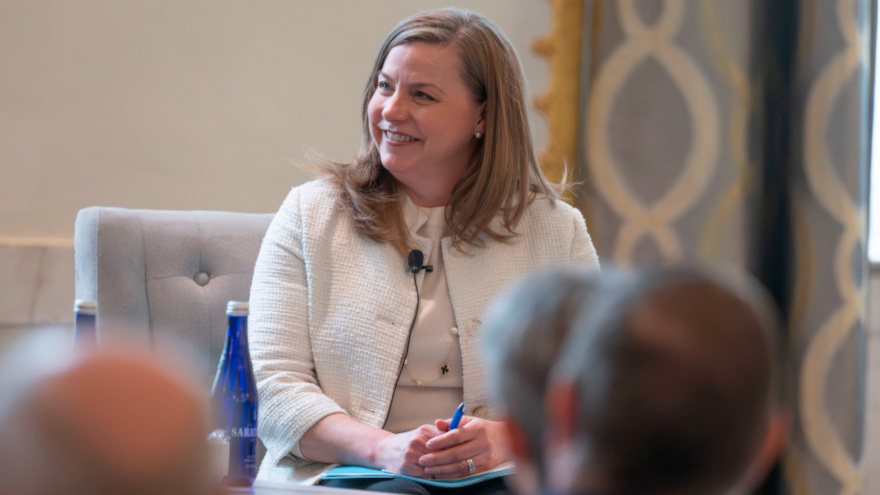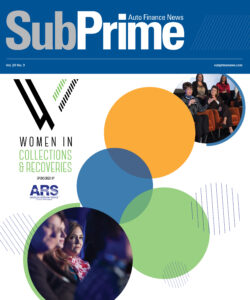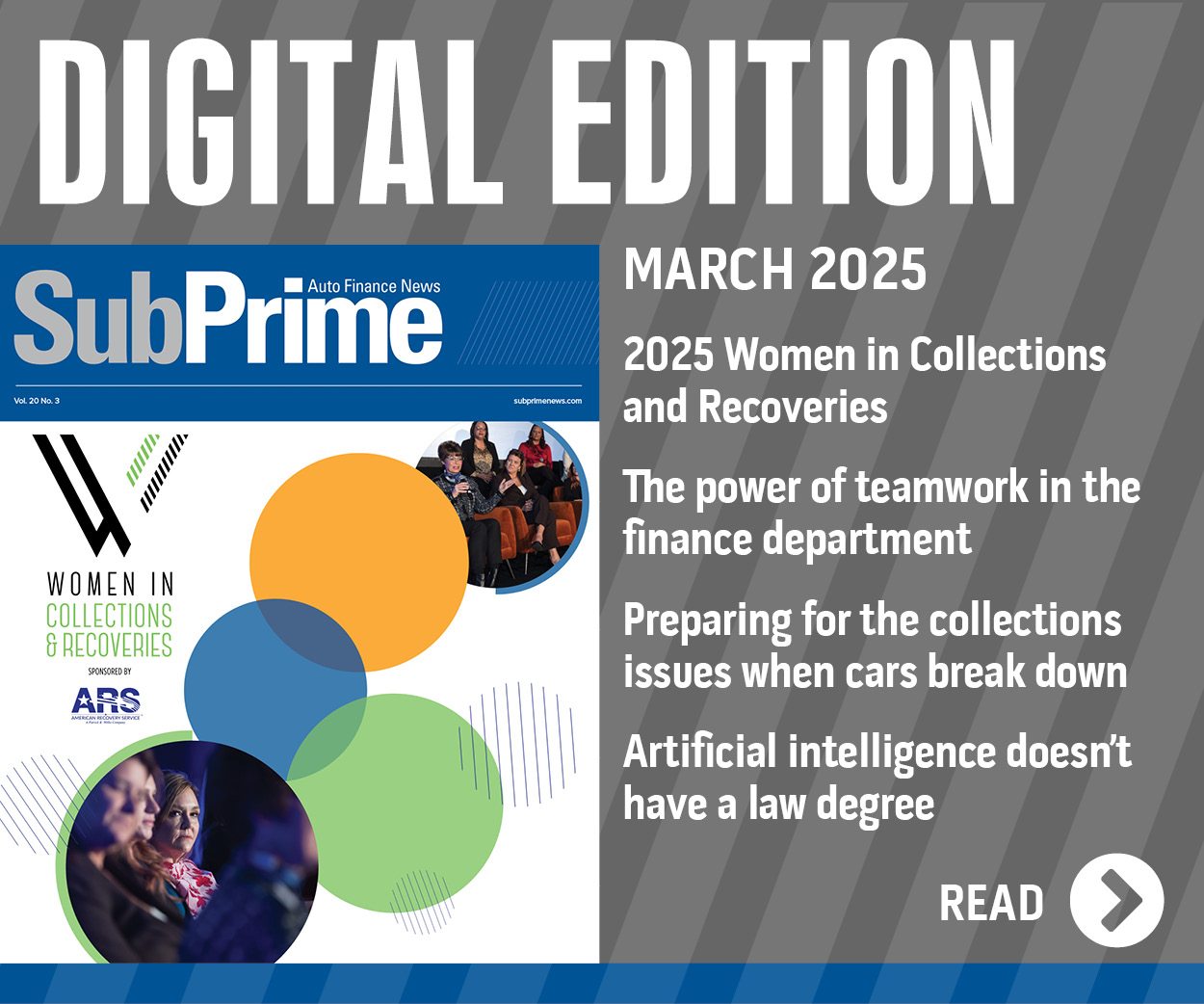Fed reiterates rate strategy in separate appearances

Federal Reserve governor Michelle Bowman is pictured at the Exchequer Club Luncheon in Washington, D.C., on Feb. 21. Image courtesy of the Fed.
Federal Reserve chair Jerome Powell and Fed governor Michelle Bowman made separate public appearances on Thursday, but each policymaker maintained similar stances on how the entity is approaching interest rates and inflation.
Appearing before the U.S. House Financial Services Committee to give the Federal Reserve’s semiannual monetary policy report, Powell acknowledged that inflation still hasn’t retreated to what the Fed targets.
“The Federal Reserve remains squarely focused on our dual mandate to promote maximum employment and stable prices for the American people. The economy has made considerable progress toward these objectives over the past year,” Powell told lawmakers.
“While inflation remains above the Federal Open Market Committee’s (FOMC) objective of 2 percent, it has eased substantially, and the slowing in inflation has occurred without a significant increase in unemployment. As labor market tightness has eased and progress on inflation has continued, the risks to achieving our employment and inflation goals have been moving into better balance,” Powell continued.
“Even so, the committee remains highly attentive to inflation risks and is acutely aware that high inflation imposes significant hardship, especially on those least able to meet the higher costs of essentials, like food, housing, and transportation. The FOMC is strongly committed to returning inflation to its 2 percent objective. Restoring price stability is essential to achieve a sustained period of strong labor market conditions that benefit all,” he went on to say.
While Powell was on Capitol Hill, Bowman was in Somerset, N.J., giving a speech during the New Jersey Bankers Association’s Economic Leadership Forum. Like Powell, Bowman emphasized that the FOMC has significantly tightened the stance of monetary policy to address high inflation, keeping the federal funds rate target range at 5.25% to 5.5% after its latest opportunity to make a change in January.
Bowman said the latest 12-month readings through January of total and core personal consumption expenditures (PCE) inflation dropped to 2.4% and 2.8%, respectively. She indicated that’s the lowest rates the Fed has seen for those metrics since early 2021.
“Although inflation declined over the second half of 2023, the January inflation data suggest that progress in bringing inflation down further may be slower going forward,” Bowman told the bank gathering in the Garden State. “Throughout this time, economic activity has remained strong with ongoing strength in consumer spending.
“We had also seen signs of the labor market coming into better balance, but recent strong jobs reports — including upward revisions to employment growth — show a continued tight labor market,” she continued. “Last year, the average pace of job gains slowed and the labor force participation rate rose through November, with the unemployment rate edging up to 3.7 percent. In recent months, however, job growth has rebounded, and the labor force participation rate declined, retracing some of its earlier gains.”
Bowman then gave a glimpse about how she will approach the Fed’s next opportunity to modify interest rates. That chance comes after the FOMC’s next meeting on March 20.
“At its current setting, our monetary policy stance is restrictive and appears to be appropriately calibrated to reduce inflationary pressures,” Bowman said. “As I’ve noted recently, my baseline outlook continues to be that inflation will decline further with the policy rate held steady, but I still see a number of upside inflation risks that affect my outlook. These include risks from geopolitical developments, including the risk of spillovers from geopolitical conflicts and the extent to which food and energy markets and supply chains remain exposed to these influences.
“There is also the risk that a loosening in financial conditions and additional fiscal stimulus could add momentum to demand, stalling any further progress or even causing inflation to reaccelerate,” she continued. “Finally, there is a risk that continued labor market tightness could lead to persistently high core services inflation. Recent labor market data suggest ongoing elevated wage growth as some businesses continue to report above-average wage increases to compensate for elevated prices and high inflation.”
Bowman acknowledged that revisions to key data reports “make the task of assessing the current state of the economy as well as predicting how the economy will evolve even more challenging, and I will remain cautious in my approach to considering future changes in the stance of policy.”
But the FOMC member doesn’t appear to want to cut interest rates just to please certain consistencies like auto finance companies.
“Should the incoming data continue to indicate that inflation is moving sustainably toward our 2 percent goal, it will eventually become appropriate to gradually lower our policy rate to prevent monetary policy from becoming overly restrictive,” Bowman said. “In my view, we are not yet at that point. Reducing our policy rate too soon could result in requiring further future policy rate increases to return inflation to 2 percent over the longer run.”
Bowman left the New Jersey gathering with one more thought about how the Fed will proceed.
“It is important to note that monetary policy is not on a preset course,” Bowman said. “My colleagues and I will make our decisions at each FOMC meeting based on the incoming data and the implications for the outlook.
“While the current stance of monetary policy appears to be at a restrictive level that will bring inflation down to 2 percent over time, I remain willing to raise the federal funds rate at a future meeting should the incoming data indicate that progress on inflation has stalled or reversed. Restoring price stability is essential for achieving maximum employment and stable prices over the longer run.”

 View The Latest Edition
View The Latest Edition

